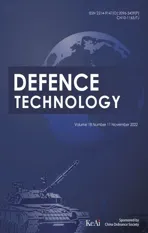Damage behavior of the KKV direct hit against fluid-filled submunition payload
2022-11-28YangZanHaifuWangYuanfengZhengHuanguoGuo
Yang Zan,Hai-fu Wang,Yuan-feng Zheng,Huan-guo Guo
State Key Laboratory of Explosion Science and Technology,Beijing Institute of Technology,Beijing,100081,China
Keywords:Kinetic kill vehicle Tactical ballistic missiles Submunition payload Direct hit Damage behavior
ABSTRACT The damage effects of fluid-filled submunition payload impacted by the kinetic kill vehicle(KKV)are investigated by simulations and ground-based experiments.Numerical simulations showed that the damage level and number of submunitions were significantly influenced by the diameter of the KKV compared with its length.Based on that,a high velocity penetrator formed by shaped charge explosion was used to simulate the direct hit experiment of a KKV impacting submunition payload.Experimental results demonstrated that the damage modes of submunitions mainly included the slight damage,perforation and total smash,showing a good agreement with the simulations.To understand the multiple damage modes of submunitions,the damage behavior of the submunitions in direct hit process were analyzed based on the AUTODYN-3D code.Numerical results presented that increased KKV diameter can increase the crater diameter and expand the damage volume,which will achieve a higher direct hit lethality.Further analysis indicated that there were other mechanical behaviors can enhance the damage to submunitions not lying in the KKV flight path,such as secondary debris kill,neighboring submunitions collision with each other,and high-speed fluid injection effect.
1.Introduction
Tactical Ballistic Missiles(TBM),which have the characteristics of short flight time and strong defense penetration ability,have posed a great challenge to air defense and anti-missile weapon system.To effectively intercept TBM,advanced fragmentation warhead,kinetic energy rod warhead with alignment technology and kinetic kill vehicle(KKV)interception techniques are used in anti-missile systems.Among them,direct hit technology of KKV is considered as one of the main means adopted by current midcourse anti-missile systems[1,2].With the capability of autonomous flight and target identification,the KKV can direct collide with and destroy the payload bay of the ballistic missile through its huge kinetic energy[3,4].
At present,the United States leads the world in the field of midcourse anti-missile by using the KKV direct hit technology,such as the famous exoatmosphere kill vehicle(EKV)and lightweight exoatmospheric projectile(LEAP)[5-7].Over the past twenty years,the U.S.Navy and Air Force conducted a series of regular intercept flight tests,including many full-scale,1/2-scale and 1/4-scale ground-based experiments,to verify performance and confirm the technological progress of the Ballistic Missile Defense System[7,8].The latest test by the United States showed that the Standard missile-3 2A(carrying the LEAP)successfully intercepted an intercontinental ballistic missile[9].However,for reasons of confidentiality and so on,no further details of the intercept technology have been published.
Due to the limitations of ground ultra-high-speed launch technology and the cost of actual tests,many studies about the damage effects of the KKV direct hit against the submunition payload have been conducted by the theoretical calculation and numerical simulation.Based on TATE penetration theory[3],ALPHAKV and OPTKV analysis models were established to estimate the lethality of kill vehicle against submunition payloads[10].Doup et al.proposed a volume overlap analysis model based on the interceptor"s penetration encounter trajectory[11].Wang WJ et al.established a damage probability model of debris cloud produced by KKV intercepting TBM[12].Anderson Jr.et al.conducted numerical simulations to study the penetration behavior of chemical submunition payload by tungsten-alloy long-rod projectiles,and their results were used to assess the modified Bernoulli model of TATE[13].In addition,our research group has also devoted large amount of effort to investigating the penetration behavior and damage effects of the submunition payloads impacted by the KKV since the year of 2010.As a part of the effort,representative researches on the KKV direct hit technology include damage experiments of high velocity penetrator on submunition payloads[14],lethality analytical model of KKV against submunition payloads[15,16],and numerical simulation of KKV impacting the submunition payloads[17].
These studies show that the damage effects of the fluid-filled submunition payloads are related to multiple factors,such as impact angle,hit point and encounter velocity of the KKV.However,there are still considerable challenges in whether all the submunitions on payload can be completely destroyed at one stroke even under the successful encounter.Apart from the endgame encounter conditions,the influence of the geometry size of KKV on the damage lethality should also be considered.In addition,the mechanical behavior involved in the KKV impacting the fluid-filled submunition payload is relatively complex,and the damage mechanism has not been well understood.
In the paper,the target analysis and structure equivalent of submunition payload and the KKV are firstly investigated.Secondly,the damage effects of submunition payloads under the KKV with different diameters and lengths are simulated.Then the groundbased experiments of simulated KKV against fluid-filled submunition payload are carried out.Finally,the damage mechanism and multiple damage modes of fluid-filled submunitions caused by the KKV direct hit are analyzed.
2.Direct hit simulations
2.1.Numerical method and material model
The direct hit behaviors of the KKV against fluid-filled submunition payloads were simulated based on the AUTODYN-3D code.The equivalent model of the payload is shown in Fig.1(a),which included of a skin,separators,and submunitions.Usually,the geometric shape of payload skin is simplified as a truncated cone[16,17].The skin material is 45# steel,the thickness is 2 mm,the length is 419 mm,the upper and bottom diameters are 220 mm and 320 mm,respectively.The array of submunitions are shown in Fig.1(b),and a total of 38 submunitions are arrayed in three layers.The upper layer contained 8 submunitions while the middle and lower layer contained 12 and 18 submunitions,respectively.The material of submunition shell is 4340 steel,the diameter is 53 mm and the length is 133 mm.The fluid inside is replaced by water in the simulation.The material of the separator is 2024 aluminium(Al)and its thickness is 5 mm.The payload skin,submunition shell and water were calculated by the Lagrange method.
In fact,the internal structure of a KKV is complex,mainly including the detector,attitude control propulsion system,data processing and guidance system et al.[18].The geometry and physical parameters of these components are difficult to obtain due to their different shapes and complex distributions.However,the KKV relies on direct impact to kill incoming missile,as a result,its damage efficiency is closely related to its outline dimension and mass characteristics.Therefore,the outline dimension is mainly considered when a KKV is equivalent,while the internal structure and component size can be ignored.For the US LEAP,it can be regarded as a homogeneous cylinder,and the KKV material is 2024 Al in this paper,as shown in Fig.1(c).
The entire model of a KKV impacting the submunition payload mainly consists of five parts:payload skin,submunition shell,fluid,separator and the KKV.Detailed material strength models and EOSs are shown in Table 1,in which the erosion model of these material parameters referenced[17].

Table 1Material strength models and EOSs of the KKV and payload each part[17].
Considering that the endgame encounter velocity of a KKV impacting ballistic missile warheads is usually above 2 km/s,shock EOS(Mie-Gruneisen EOS)is used to describe the stress-strain relationship of materials under high-velocity impact.Mie-Gruneisen EOS can be expressed as:

Where,pis pressure,vis specific volume,eis internal energy,Γ0(v0)is Mie-Gruneisen coefficient under normal circumstances,(pr(v),er(v))is the coordinate of the reference point on the Hugoniot curve andv0is specific volume under normal circumstances.
The pressure generated by KKV impacting the payload is high enough to ignore the material strength,but the material strength effect should not be ignored in the far-field region and postcollision period.Such as,the materials of payload skin,submunition shell,separator and KKV are described by the Johnson-Cook strength model,which expressed the behavior of materials subjected to high strains,high strain rates and high temperatures.This material model can be expressed as follows:

WhereA,B,C,M,Nare material constants,is effective plastic strain,andis dimensionless strain rate.Tmis melting temperature of the considered material,TandTroomare surrounding and room temperature,respectively.
In the Johnson-Cook failure model,the failure criterion and influencing factors can be expressed as:
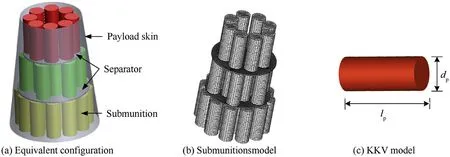
Fig.1.Numerical model of the fluid-filled submunition payload and KKV.

WhereD1,D2,D3,D4,D5are the material parameters and σ*is effective stress.The material failure occurs whenD=1.0.The failure model of 45# steel and 2024 Al material parameters were obtained from Refs.[19,20],and the failure model of 4340 steel was derived from the material library in AUTODYN.Material parameters of finite element modelling of #45 steel,4340 steel,2024 Al,and water are shown in Table 2.
2.2.Influences of the KKV diameter
The damage effects of direct hit KKV against the submunition payload are related to not only the impact conditions(such as impact point,impact velocity and impact angle)[19,20],but also the geometric size of the KKV.Under the same endgame encounter,the influences of the KKV diameter on damage effects of the payload are mainly studied.The KKV lengthlpis 150 mm,and its diameterdpis 40 mm,60 mm,80 mm,120 mm and 140 mm respectively.When the KKV with different diameters impacts the geometric centerline of the payload at a strike angle of 90°and a velocity of 2.4 km/s,the overall direct hit lethality of the submunition payload is shown in Fig.2.And the damage effects of fluidfilled submunitions in each layer are shown in Figs.3-7 respectively.
Numerical simulations demonstrate that the damage degree and damage area of the submunition payload gradually increase with the KKV diameter increasing from 40 mm to 140 mm,as shown in Fig.2.Obviously,when a high-speed KKV impacts the submunition payload,it can completely fracture many submunitions,especially the submunitions that lie in a direct path of the KKV.According to the fluid loss inside the submunition influence on combat effectiveness,the damage mode of submunition can be divided into four levels,as listed in Table 3.

Table 2Material parameters of the KKV and fluid-filled submunition payload each part.

Table 3Damage level description of the fluid-filled submunition.
When the KKV diameter is 40 mm,the middle layer submunitions are strongly damaged under the direct impact of the KKV,and some submunitions in the other two layers are perforated or slightly dented,as shown in Fig.3.Under the direct hit of the KKV with a diameter of 60 mm(Fig.4),submunitions in the upper layer are perforated to varying degrees,and those in the middle layer are completely shattered and the shells completely lose the initial cylindrical shape.There are four damage modes in the lower layer submunitions.As shown in Fig.5,when the KKV diameter is 80 mm,the middle layer submunitions that lie in direct contact with the KKV are totally smashed,and the submunitions in upper and lower layers have different degrees of perforation.Especially,comparing with Figs.3(a)and 4(a),the damage level of submunitions in Fig.5(a)is more serious,mainly manifested as the remaining undeformed length of the damaged submunition less than half of its initial length.
When the KKV diameters are 120 mm and 140 mm,all submunitions in the middle layer are completely destroyed and not found any fragments even small pieces,as shown in Figs.6 and 7 respectively.It can be seen from Fig.6 that all submunitions in the upper and lower layers are severely perforated,and the lengths of the remaining shells are less than half of the initial length.Whereas,when a 140 mm diameter KKV impacts the fluid-filled submunition payload,the remaining lengths of all submunitions in the upper and lower layers are less than one third of the initial length,and these damaged submunitions have completely lost fluid storage capacity.
The influence of KKV diameter on the damage level and number of the fluid-filled submunitions is shown in Fig.8.Numerical simulations show that the KKV diameter has a significant influence on the destructive effect of the submunition payload.With the KKV diameter increasing from 40 mm to 120 mm,the number of smashed submunitions dramatically grows,and the damage ratio increases from 26.3%to 100%.As such,all fluid-filled submunitions on this type payload are completely damaged under the direct hit of the high-speed KKV when its diameter is larger than 120 mm.This is mainly because the KKV diameter directly determines the size of its penetration channel,including a crater depth and a crater diameter.Based on the TATE model[3],the crater diameter is proportional to the KKV diameter.Therefore,increased the KKV diameter can enhance the crater volume,killing more submunitions on payload.
2.3.Influences of the KKV length
When a KKV impacts the submunition payload,the interceptor will begin to erode and decelerate,dispersing its mass and momentum.To study the influence of the KKV length on the overall lethality of submunition payload,four scenarios are numerically simulated.The KKV diameterdpis 100 mm,and its lengthlpis 40 mm,60 mm,80 mm and 200 mm respectively.The KKV impacts the middle layer of payload at a strike angle of 90°and a velocity of 2.4 km/s.Under the direct hit of KKV with different lengths,thedamage effects of submunition payloads are shown in Fig.9,and the damage results of submunitions in each layer are shown in Figs.10-13 respectively.

Fig.2.Overall lethality of the submunition payloads impacted by KKV with different diameters.

Fig.3.Damage effects of submunitions when the KKV diameter is 40 mm:(a)The upper layer submunitions,(b)The middle layer submunitions,and(c)The lower layer submunitions.

Fig.4.Damage effects of submunitions when the KKV diameter is 60 mm:(a)The upper layer submunitions,(b)The middle layer submunitions,and(c)The lower layer submunitions.
As shown in Fig.9,when the KKV length increases from 40 mm to 200 mm,there is a slight difference in the overall damage of submunition payloads.The simulations demonstrate that with the KKV length increasing from 40 mm to 60 mm,the number of very strongly damaged and totally smashed submunitions grows significantly,and the submunition damage ratio increases from 57.9% to 81.6%.However,when the KKV length increases from 60 mm to 80 mm,the number of smashed submunitions does not improve dramatically,as shown in Fig.14.Especially,comparing with Figs.12 and 13,when the KKV length is 200 mm,the damage effects of all the submunitions are almost the same as those of the 80 mm KKV.As such,for the given KKV diameter and endgame encounter,when the KKV length is greater than 80 mm,further increasing its length does not contribute to the damage level and number of submunitions.
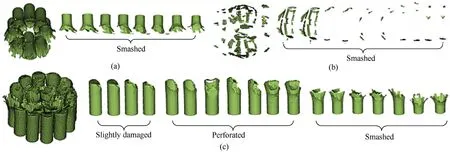
Fig.5.Damage effects of submunitions when the KKV diameter is 80 mm:(a)The upper layer submunitions,(b)The middle layer submunitions,and(c)The lower layer submunitions.

Fig.6.Damage effects of submunitions when the KKV diameter is 120 mm:(a)The upper layer submunitions and(b)The lower layer submunitions.

Fig.7.Damage effects of submunitions when the KKV diameter is 140 mm:(a)The upper layer submunitions and(b)The lower layer submunitions.
This is mainly due to the fact that the KKV is fractured during the high-speed collision with the payload,and its length is gradually eroded away.The KKV with shorter length will be totally eroded before it penetrates the payload,which will affect the destructive effect.Appropriately increasing the KKV length can effectively enhance the overall damage.However,excessive length of KKV has no significant effect on the improvement of the overall lethality.For a given KKV diameter,the longer interceptor will have higher mass and lower impact velocity under the same launch condition,which will make a great impact on the overall lethality of the payload[3].Therefore,when the KKV impacts the payload at a strike angle of 90°,the KKV only needs a certain effective length to exert its higher lethality on the submunition payload,since the longer not always the better.

Fig.8.Damage level and number of submunitions under the KKV with different diameters.
3.Direct hit experiments
3.1.Experimental setup
It is usually difficult to obtain a high velocity penetrator with large diameter and mass by ballistic gun and light-gas gun,whereas the cost of rocket sled is relatively high.Based on the technology of shaped charge,an explosively formed projectile(EFP)can be obtained and its velocity is 2000-3000 m/s[21,22].Fig.15(a)shows the experimental device that can form a high velocity penetrator,and the typical penetrator is represented in Fig.15(b).The shaped charge mainly consisted of three parts:a liner,a main charge,and a case.The main charge was comp B explosive and it was centrally initiated through a detonator at the bottom.In order to obtain the simulated KKV with different diameters and masses,the charge diameters of shaped charge were 90 mm and 120 mm,and the length of main charge were 180 mm and 240 mm,as shown in Fig.15(c)and(d),respectively.Correspondingly,the wall thicknesses of the aluminum liner were 13.5 mm and 18 mm,and the masses were 252 g and 600 g respectively.The case,which was machined by LY12 Al,was 7.5 mm thick.
The fluid-filled submunition payload in the experiment mainly consisted of a skin,separators and submunitions,in which the size and material of payload skin and separators were the same as those in the simulations.In order to simplify the experiment,the unopened Coca-Cola cans were used to simulate submunitions containing fluid.The thickness of cans was approximately 0.2 mm.Additionally,to analyze the damage effects of submunitions in each layer after the test,the shells of the cans in the upper,middle,and lower layer were sprayed with red,green and blue paint respectively.
The schematic diagram and setup of ground-based simulation experiment are shown in Fig.16.The fluid-filled submunition payload and the device for forming a simulated KKV were placed on the horizontal bracket.By adjusting the height of the bracket,the high velocity penetrator was able to direct impact the geometric center of the payload,as shown the‘Hit point’in Fig.16(a).

Fig.9.Overall lethality of the submunition payloads impacted by KKV with different lengths.
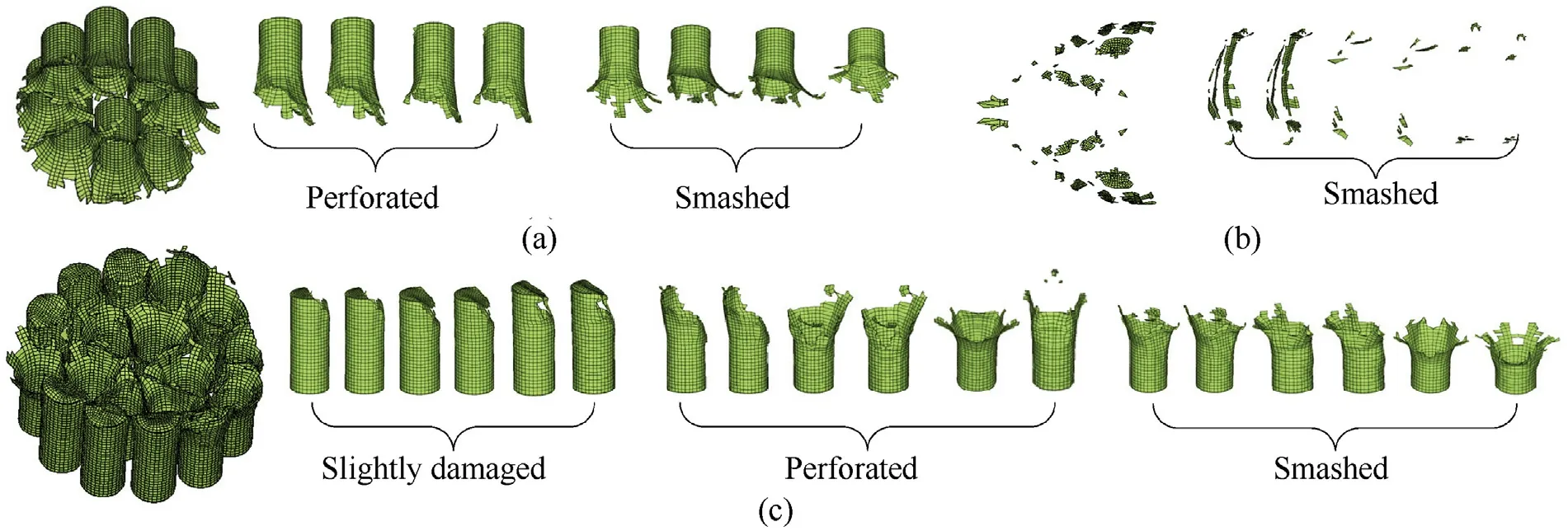
Fig.10.Damage effects of submunitions when the KKV length is 40 mm:(a)The upper layer submunitions,(b)The middle layer submunitions,and(c)The lower layer submunitions.
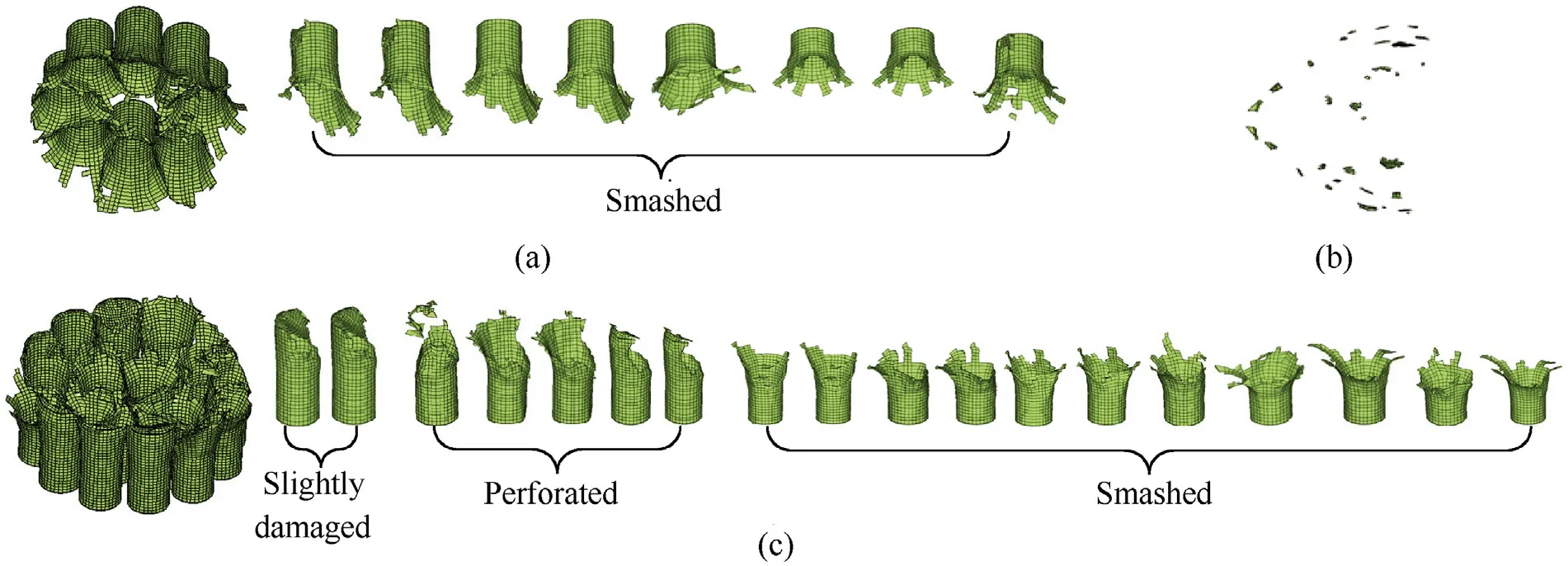
Fig.11.Damage effects of submunitions when the KKV length is 60 mm:(a)The upper layer submunitions,(b)The middle layer submunitions,and(c)The lower layer submunitions.

Fig.12.Damage effects of submunitions when the KKV length is 80 mm:(a)The upper layer submunitions,(b)The middle layer submunitions,and(c)The lower layer submunitions.
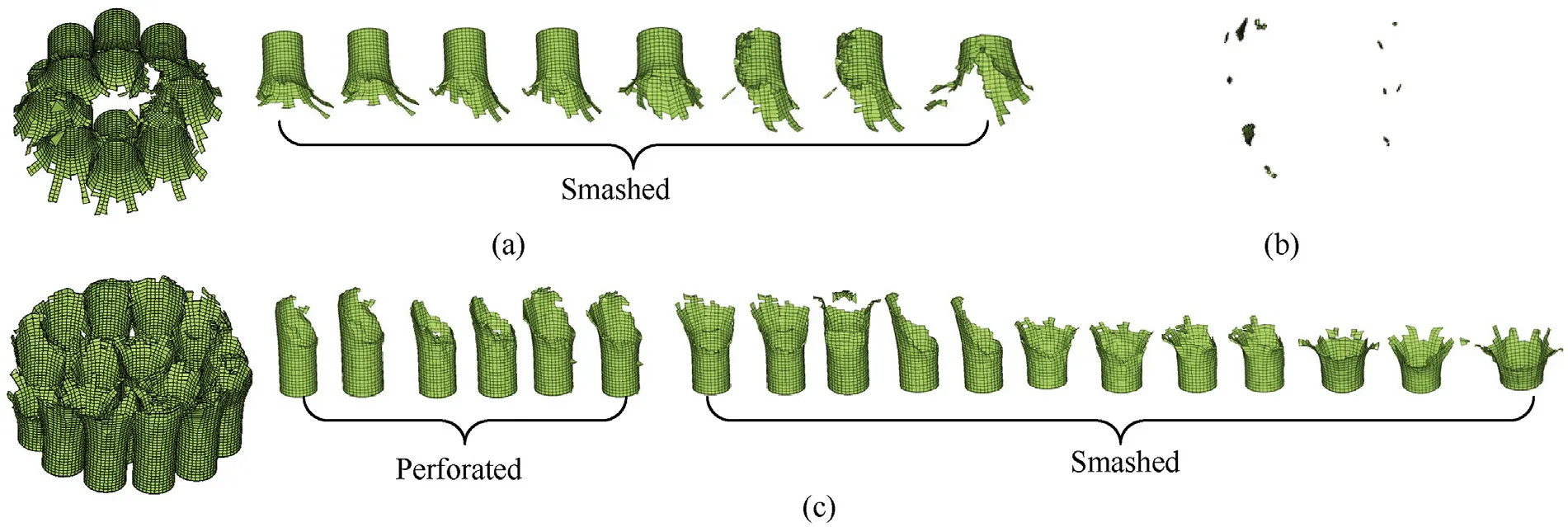
Fig.13.Damage effects of submunitions when the KKV length is 200 mm:(a)The upper layer submunitions,(b)The middle layer submunitions,and(c)The lower layer submunitions.
3.2.Experimental results
When the charge diameter is 90 mm,the typical damage effects of fluid-filled submunition payload are shown in Fig.17.Experimental results show that the metal skin is broken into several fragments,and some small fragments are even thrown so far away that could not be found within a radius of 50 m.Under the direct hit of the high velocity penetrator,7 submunitions in the lower layer(yellow)have partial holes and a handful of fluid is lost(Fig.17(b)),6 submunitions are seriously perforated and most of the fluid is leaked(Fig.17(c)),and the remaining shell length of 5 submunitions is less than half of the initial length making them without fluid storage capacity(Fig.17(d)).The submunitions in the upper layer(red)and middle layer(green)are totally smashed(Fig.21(e)and(f)).In particular,most of the middle layer submunitions are completely destroyed and only partial fragments are found.
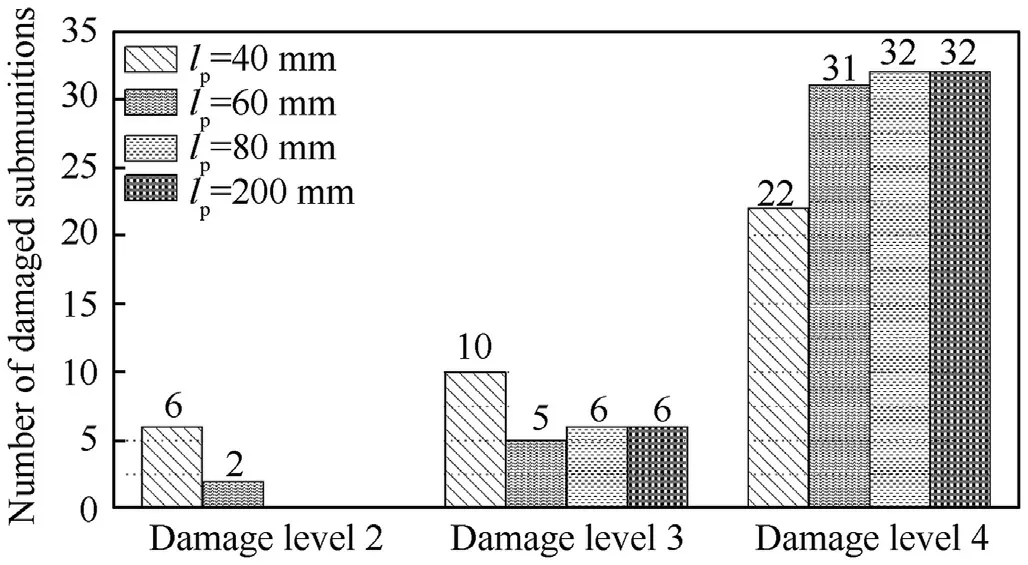
Fig.14.Damage level and number of submunitions under the KKV with different lengths.
When the charge diameter is 120 mm,the typical damage effects of the fluid-filled submunitions payload are shown in Fig.18.After the test,the payload skin is violently fractured and only one large fragment can be found(Fig.18(a)).Meanwhile,the aluminum separators are also deformed to varying degrees.As shown in Fig.18(b)-(e),the submunitions in the middle layer(green)are completely shattered and not found any fragments.The submunitions in the upper layer(red)are also completely destroyed,only 3 small pieces are found.The 18 submunitions in the lower layer(yellow)have different damage levels,5 of which are totally smashed and 7 are very strongly damaged.
Based on the numerical simulations,the velocity of two types penetrators in the experiments was approximately 2.4 km/s,the maximum diameters of penetrators were 80 mm and 108 mm,as shown in Fig.19(a)and(b),respectively.According to numerical simulations in Fig.5 and the experimental results,the damage level and number of fluid-filled submunitions are listed in Table 4.It is obvious that,with the maximum diameter(dpm)of simulated KKV increasing from 80 mm to 108 mm,the number of smashed submunitions significantly increases.The experiments further manifest that the diameter of interceptor has a great influence on the overall damage of fluid-filled submunitions.Namely,increasing the diameter of KKV can kill more submunitions on payload.
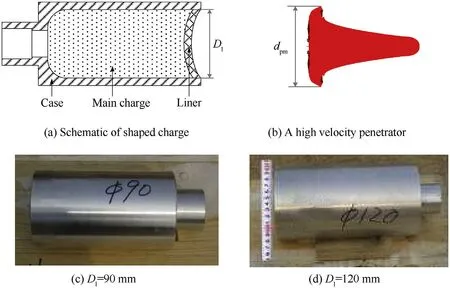
Fig.15.Experimental device forms a high velocity penetrator to simulate the high-speed KKV.
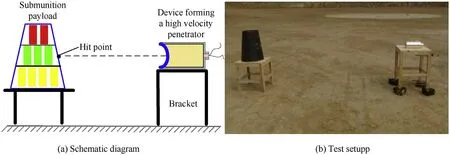
Fig.16.Simulated experiments for the KKV against fluid-filled submunition payload.

Fig.17.Typical damage effects of the submunition payload when the charge diameter is 90 mm:(a)Payload skin damage,(b)Damage level 2,(c)Damage level 3,(d),(e)and(f)Damage level 4.
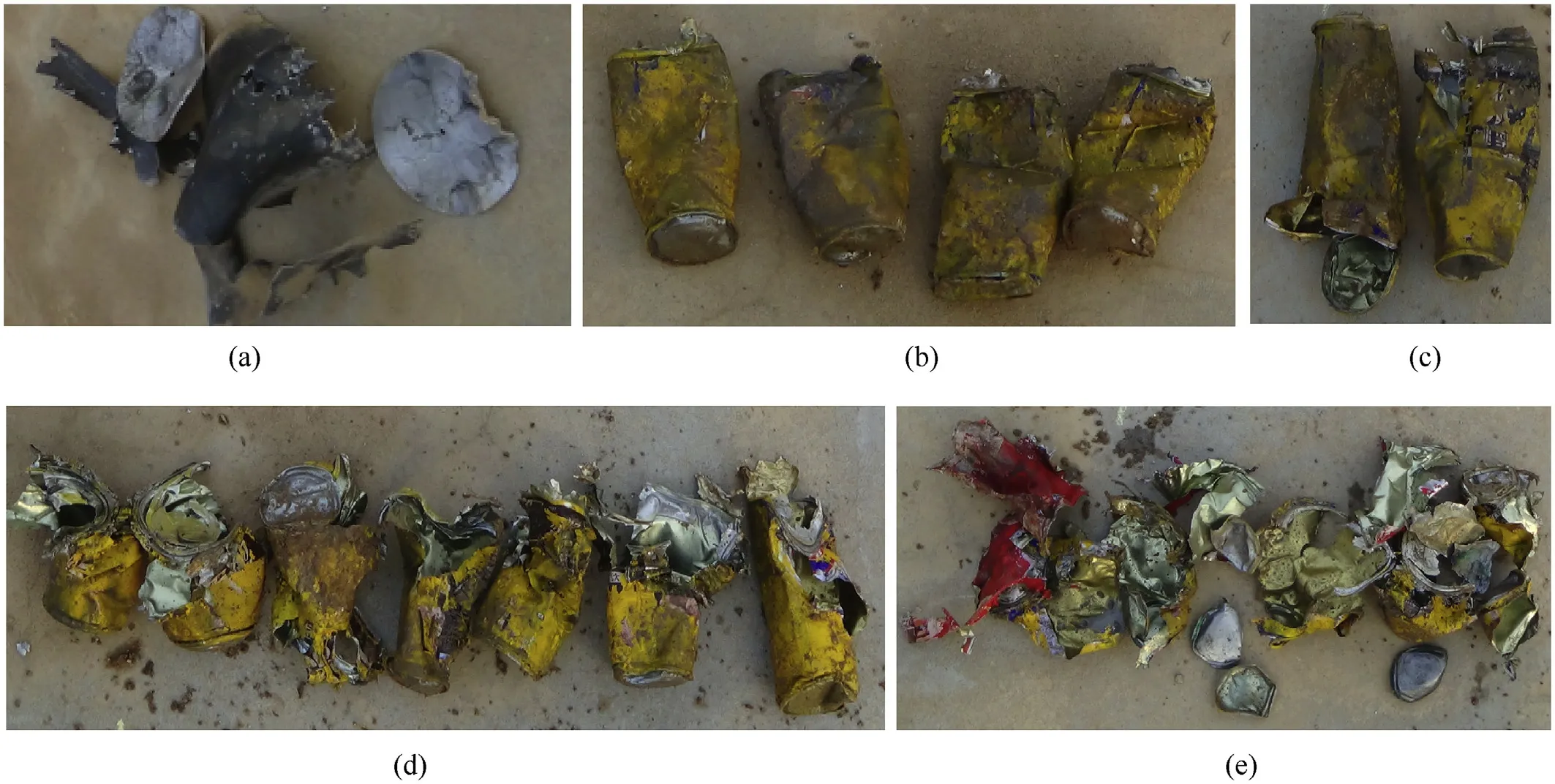
Fig.18.Typical damage effects of the submunition payload when the charge diameter is 120 mm:(a)Payload skin damage,(b)Damage level 2,(c)Damage level 3,(d)and(e)Damage level 4.
Table 4 also shows when the maximum diameter of simulated KKV is 80 mm,comparing with numerical simulations in Fig.5,there are fewer submunitions with damage level 3 and 4 in the test of Fig.17.This is mainly because the shape of KKV in numerical simulation is a cylinder,while the shape of penetrator formed shaped charge in experiment is similar to a truncated cone,which is more likely to reduce the damage effects of fluid-filled submunitions.In addition,by comparing Fig.17(e)with Fig.5(a),the red submunitions recovered after the test are damaged more seriously,showing total smash or violently radial cracking.The main reason is that the submunitions in the upper layer will fall into the KKV flight path in the test due to shock wave and gravity,so the damage mode of the upper layer submunitions is the same as those in the middle layer.There are three types of damage modes of submunitions in the lower layer in the test of Fig.17,which are consistent with the results in the numerical simulations of Fig.5.These phenomena indicate that the experiment results agree well with numerical simulations when the maximum diameter of penetrator is the same as the simulated KKV.As such,the shaped charge technology can provide an effective method to experimentally investigate the damage effects of the chemical submunition payload.

Table 4Comparisons between the experiments and simulations of damaged submunitions.

Fig.19.Structural parameters of the high velocity penetrators formed by the shaped charge.liners with a dimeter of(a)90 mm and(b)120 mm.
4.Damage mechanism analysis
4.1.Direct hit mechanism
Fig.20 presents the typical penetration process of fluid-filled submunition payload impacted by the KKV at a strike angle of 90°.Whent=35 μs,the KKV head have penetrated into the payload skin,forming a hole slightly larger than the KKV diameter.As the time progresses,the submunitions that lie on the impacting path of the KKV are seriously broken,generating a crater volume within the payload(see in Fig.20(b)).Meanwhile,the submunitions in the upper and lower layers have different degrees of slight deformation and perforation.When the KKV perforates through the aft side of payload,the damage volume of the crater gradually expands(Fig.20(d)),and more submunitions that do not lie on the impacting path are perforated severely.For mechanism consideration,under the high-speed impact,the KKV starts to compress and its head become thickened,which will make a major contributor to expand the damage volume.Based on TATE theory[3],any submunition that is physically overlapped by the damage volume is considered dead.As such,the KKV mainly relies on the expanding crater volume to obtain high lethality for the fluid-filled submunition payloads.
The crater volume is directly affected by the penetration depth and crater diameter.When the KKV perforates the payload,the crater volume is mainly determined by the crater diameter.For the purpose of quantitative analysis,the influence of the KKV diameter on the crater diameter can be studied by using the diameter at the outlet end of payload skin.As shown in Fig.21,when the KKV diameters are 40 mm,80 mm and 120 mm,the outlet diameters of damaged payloads are approximately 122 mm,260 mm and 395 mm,respectively.The numerical simulations indicate that the expanding crater diameter is approximately three times larger than the KKV diameter.The results further verify that increased the KKV diameter can increase crater diameter and enhance the damage volume,killing more submunitions on payload.
4.2.Secondary kill mechanism
It can also be seen from the simulations that the KKV,the payload skin and damaged submunition shells will also generate some debris(as shown in Figs.20(c)and 21(b)),and the debris velocity is approximately 500 m/s.These debris with small mass and low velocity may have a potential damage to submunitions not lying in the KKV flight path.As such,besides the expansion crater volume only,there could be other kill mechanisms that contributed to the overall lethality of the fluid-filled submunition payload.
In actual simulated experiments,the damage modes of Coca-Cola cans mainly include small pieces,long-shaped fragment,severe perforation,slight damage at the one end et al.To analyze the secondary kill mechanism and the multiple damage modes of fluidfilled submunitions,the outer circle and inner circle submunitions are numbered counterclockwise from the direction of penetration,as shown in Fig.22.
It was obvious that the submunitions lying on the direct path of the KKV were heavily fragmented and most of them formed small pieces,while others were long-shaped fragments.The typical formation process of these long strips is shown in Fig.23.When the time increased from 67 μs to 130 μs,the 6# and13# submunitionsunderwent dented,radial expansion and axial fracture under the direct hit of the KKV.Obviously,whent=100 μs,the deformed 13#submunition began to collide with 5#submunition.Whent=130 μs,under the combination of KKV impacting and internal fluid dynamic pressure,the shells at the lateral side of 6# and 13#submunitions fractured radially and formed some long fragments.Meanwhile,the internal fluid with high velocity ejected outward to the 5# submunition.Eventually,the damage results of 5# and 6#submunitions are shown in Fig.23(d),which agree well with the test.Therefore,the submunitions in the middle layer that located outside the main damage zone(such as 2#,3#,5#,and 6# submunitions)damaged mainly due to the submunitions collision with each other,the high-speed fluid ejection,and secondary debris kill.In addition,Fig.23(c)and(d)present that the covers of submunitions were vulnerable to failure under the internal fluid ejection,which was consistent with some covers broking off in the test(as shown in Fig.17(f)).

Fig.20.Typical penetration process of direct hit KKV against fluid-filled submunition payload.
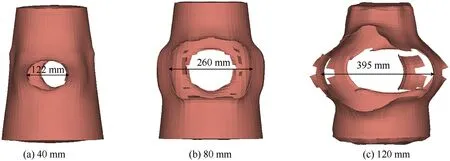
Fig.21.Damage effects of payload skin under the direct hit of KKV with different diameters.

Fig.22.Arrangement and number of the submunitions on different layers.
The damage modes of severe perforation and slight damage at the one end were commonly seen in the lower layer submunitions.Taking 13#submunition located in the inner circle of lower layer an example,the typical damage process of submunition with sever perforation is shown in Fig.24.Under the direct hit of high-speed KKV,the pressure wave was generated in the internal fluid of 7#submunition,and the impact pressure can reach to 1.0 GPa.It will cause the hydrodynamic pressure effect,thus resulting in the structural damage of submunition.Whent=83 μs,the middle 7#submunition smashed and its bottom cap plate got a certain downward speed.It collided with 13# submunition in the lower layer,which will lead the top cover to dent.As the penetration time progressed,the top portion of 13# submunition shell severely ruptured and its top cover fractured off at the weld junctions,as shown in Fig.24(d).The simulations show that the damage mode with severe perforation of 13#submunition was caused by collision with the middle 7# submunition and the hydrodynamic pressure effect.

Fig.23.Typical damage process of 5# and 6# submunitions in the middle layer.

Fig.24.Typical damage process of 13# submunition in lower layer.
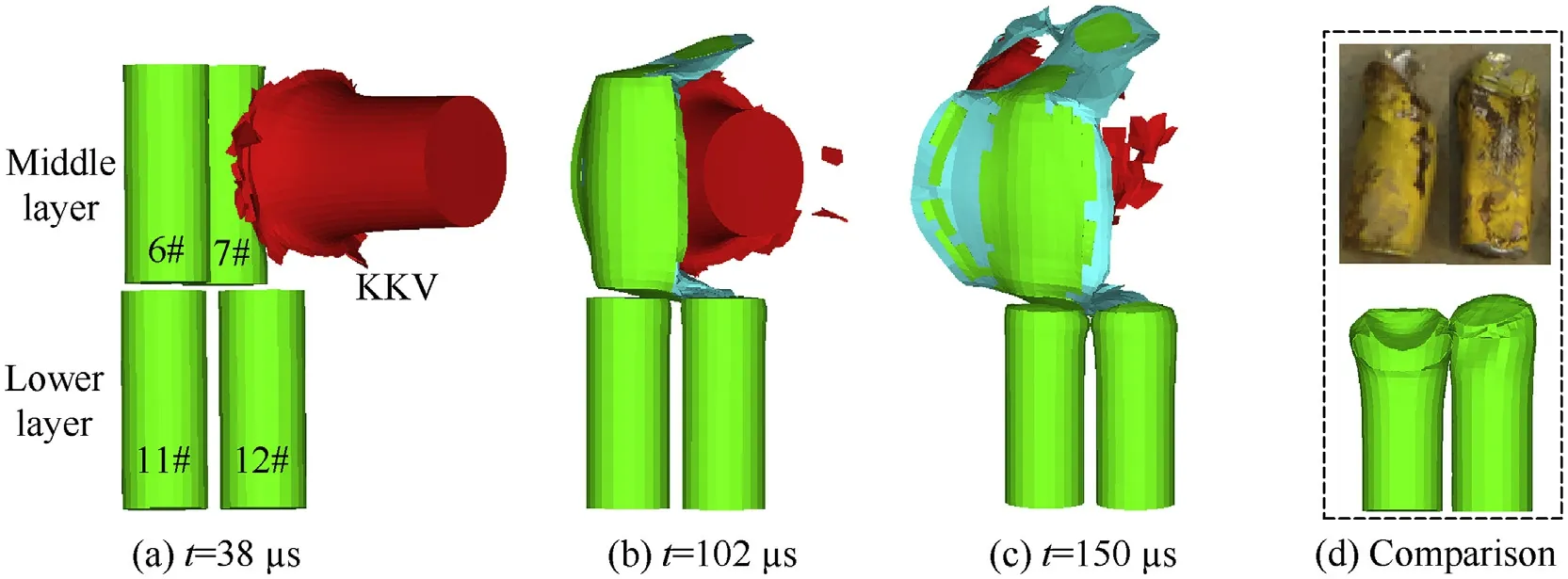
Fig.25.Typical damage process of 11# and 12 # submunitions in the lower layer.
The mode with slight damage at the one end usually occurred to the submunitions that located in the outer circle of lower layer.Fig.25 shows the formation process of a submunition with partial perforation.As the penetration time increased,the fractured bottom cap plates of the middle 6#and 7#submunitions collided with the top covers of the lower 11# and 12# submunitions.This behavior will result in a certain degree of fragmentation for the top covers in the lower layer submunitions.At the same time,the highpressure fluid in the middle submunitions ejected to 11# and 12#submunitions,further enhancing the damage effects on the lower submunitions and leakage of the liquid contained.The damage results of 11# and 12# submunitions are shown in Fig.25(d).The results indicated that the lower 11# and 12# submunitions experienced the same damage mechanism and presented the same damage mode.Their top covers violently dented and generated a perforation between the weld junctions and the top portion of the submunitions.However,the perforation degree of the submunitions was different.This is mainly due to their distance from the main damage zone,resulting in a difference in the intensity of collision between neighboring submunitions.The collision combined with the fluid dynamic pressure that may even cause an axial fracture of some submunitions,and the fracture trajectories ran the partial length or total length of the submunitions.
According to the above discussions,when a KKV directly impacted the fluid-filled submunition payload,the effective killing of submunitions mainly relied on its high kinetic energy and formed a main damage zone.But it was only one important factor for destroying the submunitions.The additional damage behaviors,such as the neighboring submunitions collision with each other,high-speed fluid injection effect,and the secondary debris kill,were also very significant to increase the overall lethality of the payload.In particular,the high temperature generated by the reentry process when a KKV intercepted the submunition payload in the exoatmosphere.It was likely to cause the full loss of fluid contained in these perforated submunitions,which will reduce the probability of posing a safety threat to the ground zone.
5.Conclusions
The damage effects and kill mechanism of the direct hit KKV against fluid-filled submunition payload were studied by numerical simulations and experiments combined.Several conclusions are presented as follows:
(a)Numerical simulations demonstrate that when the KKV impacts the payload at a strike angle of 90°,comparing with the length of the KKV,its diameter has a significant influence on the overall direct hit lethality of the submunition payload,showing a dramatical increase with the increase of the diameter.
(b)The experimental results indicate that the shaped charge explosion-formed a high velocity penetrator technology can provide an effective method to experimentally investigate the damage effects of the fluid-filled submunition payload.
(c)For mechanism considerations,the crater expansion formed by the KKV direct hit is not the only factor causing the submunitions damage.Other mechanical behaviors,such as the secondary debris kill,the neighboring submunitions collision with each other,and high-speed fluid injection effect,have additional damage effects on submunitions.
Declaration of competing interest
The authors declare that they have no known competing financial interests or personal relationships that could have appeared to influence the work reported in this paper.
Acknowledgments
This research is supported by the National Natural Science Foundation of China(No.12002046),and also supported by the State Key Laboratory of Explosion Science and Technology of China.
杂志排行
Defence Technology的其它文章
- Modified couple stress and thickness-stretching included formulation of a sandwich micro shell subjected to electro-magnetic load resting on elastic foundation
- Recent advances in the synthesis and energetic properties of potassium-based potential green primary explosives
- Investigation of normal,lateral,and oblique impact of microscale projectiles into unidirectional glass/epoxy composites
- A quasi-isentropic model of a cylinder driven by aluminized explosives based on characteristic line analysis
- Kevlar fabric reinforced polybenzoxazine composites filled with silane treated microcrystalline cellulose in the interlayers:The next generation of multi-layered armor panels
- Experimental study on the cavity evolution and liquid spurt of hydrodynamic ram
